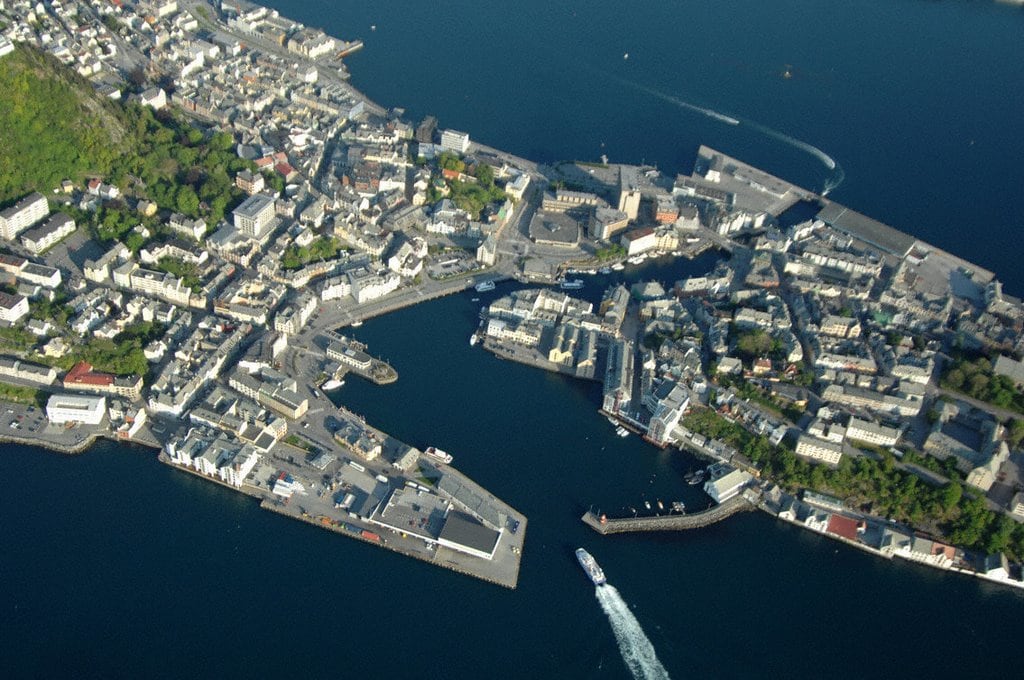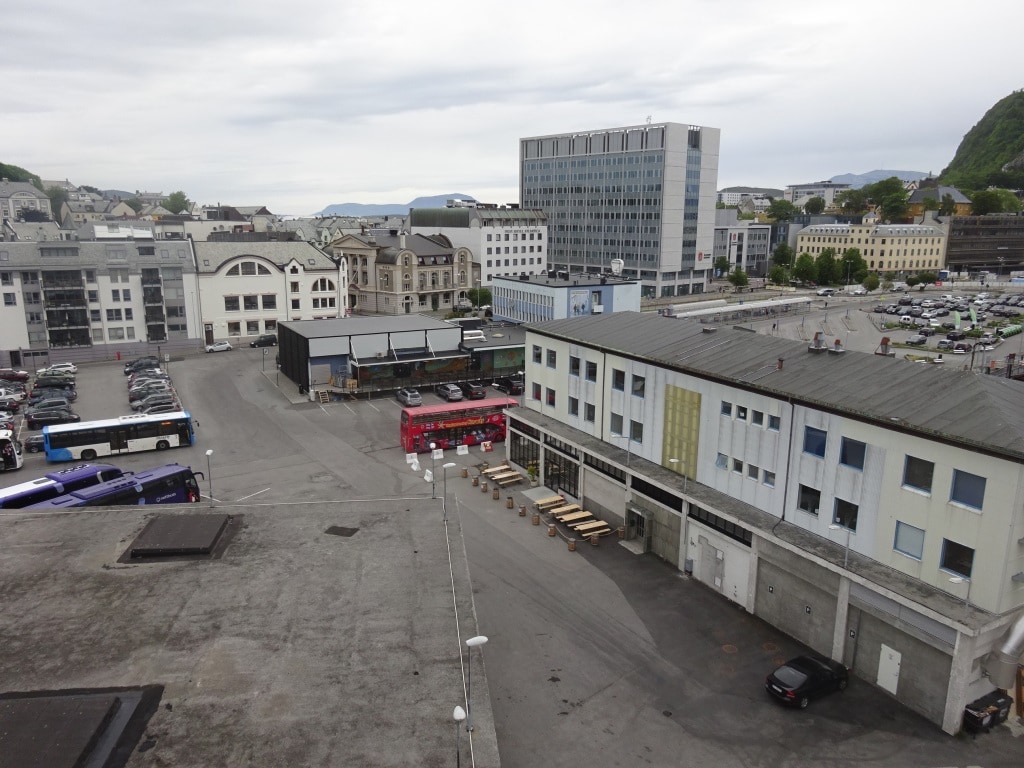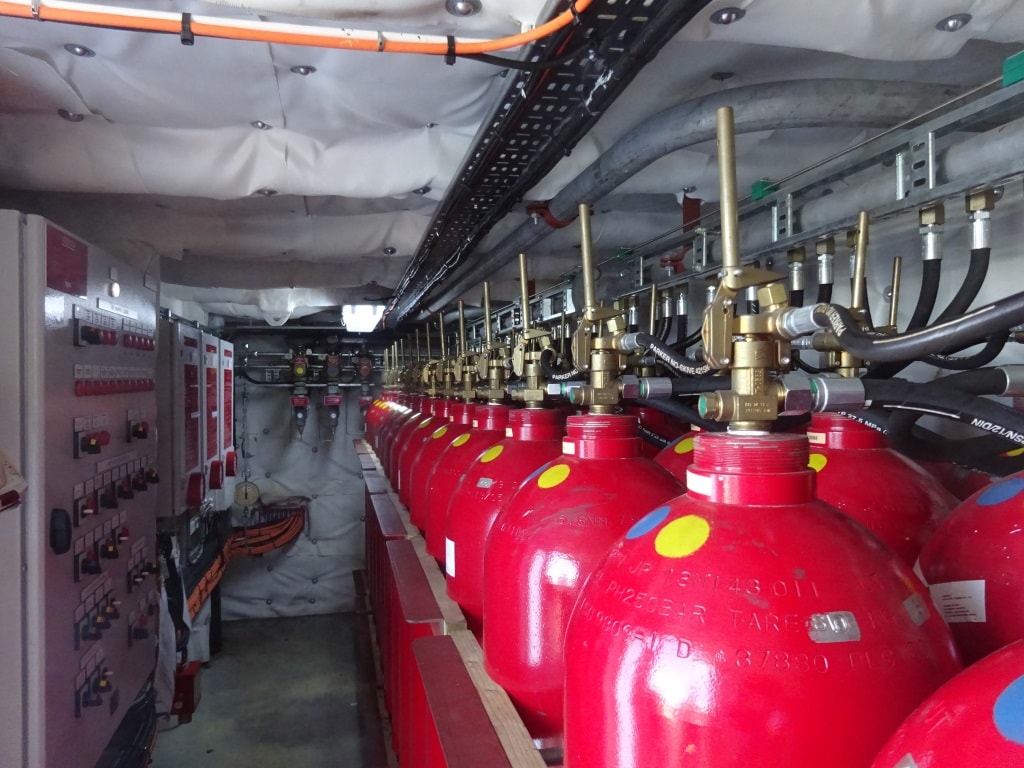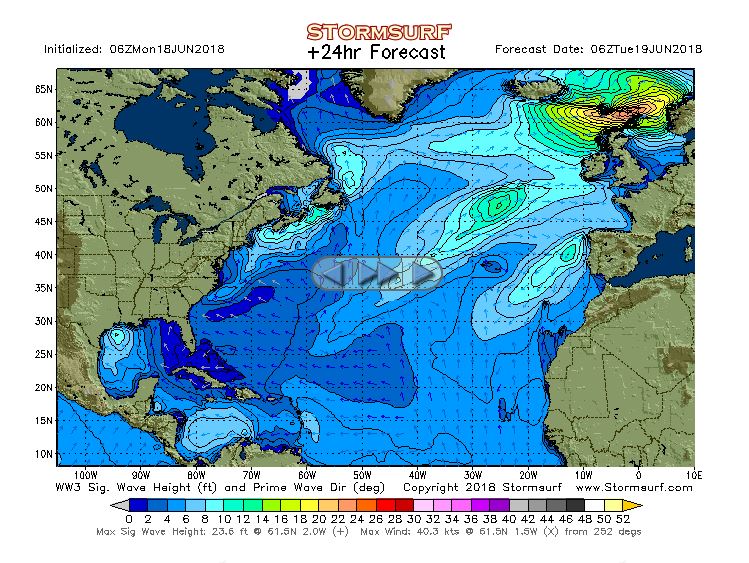Alesund is a sort of perfect smaller port for cruise ships. It is sheltered and not too deep inland. It takes hours to get to Oslo and to Geiranger (where we are tomorrow) but Alesund is nicely hidden behind a mountain range and it takes less than an hour from the pilot station to the dock. A very clever clog who decided to put a town here. Because it straddles a sort of land tongue it has a port on both sides of the city and a sort of Canal / channel setup in between for small boats. This means that ships can dock at both sides of the town and still be close to downtown. Ideal for cruise ships and ideal for Cruise Company’s as there is room for quite a few cruise ships. We docked in the old harbor today as we were the only cruise ship in port.

Alesund from the air with the inner harbor and little channel which connects both dock areas of Alesund.
Is there enough to do for the guests? Only the fact that they have a big red hop on – hop off bus making the rounds should be enough to stop that argument. It is also one of the reasons by the Prinsendam is staying longer here than normal. As we do not sail until 22.00 hrs. 2nd reason is tomorrow we go to Geiranger which is about 60 miles up the fjord and that fjord starts here at Alesund. So no reason to hurry or to sail early. I have done the city tour here some years in the past and that is really a fascinating thing to do as only by going on a tour with a good narration it gives you a good perspective of what Alesund was and is. It is my favorite Norwegian port and that is because of the large numbers of buildings that were designed and built in Art Noveau style. This happens to be my favorite years of Ocean Liner history and my interest has sort of spilled over into buildings. And you can lay close connections between the design of the ships interiors and of buildings on land.

The older Art Noveau buildings near the dock in between more modern architecture.
The reason for this concentration of buildings all of the Jungendstil or Art Noveau School is because in 1904 almost the whole (wooden town) burnt down. The German Emperor who used to vacation in this area sent a lot of help with materials and know-how and the town was rebuilt in what was then the cutting edge of Architecture. So although the area is very ancient in years of occupation the town itself is in image not much older than 100 years.
But I did not get the chance to do some admiring of the downtown area as I was responsible for creating a lot of mayhem on board today. Every 7 days we are legally required to stage a fire, mustering and abandon ship drill and when on board, I normally get involved as I can give the ship something more elaborate in scenario’s and un-expected things. I have the time to organize it and can keep it to myself so nobody really knows what to expect. In real life a fire does not announce itself either and thus the more you prepare for the un-expected the better it is. Today we focused on CO2 procedures for the Engine Room and then for the ripple……… that flows away from that occurrence and affects the whole ship. If there is a big fire in the main engine room it might stop most or all of our power and when not stopped quickly, could cause the end of the ship.

Not as pleasing to the eye as Jugendstil or Art Noveau, but highly efficient. It takes 60 of these bottles to flood the main engine room of the ship.
Golden Rule is, if there is an engine fire and you are not certain in the first 2 or 3 minutes that you can stop it without CO2, and then you should release CO2. In the past there was always a sort of reluctance to quickly engage CO2 because it could cause the lights to go out and the ship loose its option to maneuver. (Quite important in bad weather or close to rocks and other shallow patches) Through experience companies have learned that you should release CO2 the moment you are in doubt because at least you then have a good change to save the ship and all on board. And that we did this morning. A simulated big fire and based on the scenario provided, the Chief Engineer had 3 minutes to decide what his options were and then to contact the Captain for discussion so the Captain could make a quantified decision. The Master of the Vessel makes the decision whether to release CO2 and when, as he is the only one who has the complete oversight; of Navigation (info by the Navigator) the ships safety (info by the Staff Captain), the Engine situation (info by the Chief engineer) and the guest/hotel situation (info by the Hotel Director) Unless there is direct danger of hitting the rocks, Captains will be very fast in ordering CO2 release. The industry norm is to have a total flooding of an area with CO2 within 15 minutes of the occurrence of a major engine fire. Releasing CO2 is easy, you basically pull a handle and it goes. But you want all engineers and others out of the affected spaces, you want to only flood the affected areas, you want to make sure you have monitoring teams in place and you want to make sure that the guests are well aware of what is going on. For that we look at a maximum of 10 minutes before we go for it. That needs a well-trained team with good communication and that we trained on this morning. The only thing we could not train was the waiting time before we are allowed to re-enter the affected space (Could be as long as 24 hours), we could only simulate that as at 11.30 Guest lunch started again.
Tomorrow we are in Geiranger, nicely sheltered deep in the Geiranger Fjord. This is an anchor port and we will use our little shuttle tenders to and from the ship.
Weather for tomorrow does not look that great. With the rain that has come through and the approach of the storm system, we are expecting frequent showers, temperatures around 10oC or 50oF and a chilly but light wind. Double socks for me tomorrow.
And during tomorrow we will keep a close eye on the weather, as the storm has not dissipated but is still coming closer. This afternoon the rain band in front of it came over, and it is a game of wait and see how close it will come to the Norwegian Coast and how much swell we will have to contend with.

See top right, some nasty stuff is approaching Norway. the one thing we do not know is will it stay the same or will it dissipate when touching the coast; and how much will still be there when we have left Geiranger. (Courtesy www. Stormsurf.com)

June 18, 2018 at 2:03 pm
Do they not use the Sea Walk platform in Geiranger?
June 19, 2018 at 12:16 pm
Thank you for reading my blog.
Use of the Sea Walk is optional and only available for ships that get the “downtown anchorage” as that is as far as the sea walk reaches.
We have been assigned an anchorage further out.
Best regards
Capt. Albert